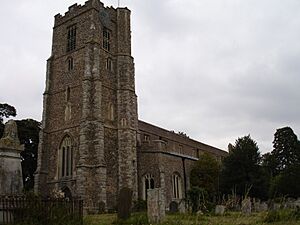Hatfield Regis Priory facts for kids
Hatfield Broad Oak Priory, also known as Hatfield Regis Priory, was once a Benedictine monastery in Hatfield Broad Oak, Essex, England. It was started by 1139 and closed down in 1536 during King Henry VIII's time, when many monasteries were shut.
A Look Back at Hatfield Priory
The area of Hatfield was already a big settlement when the Normans took over England. The Domesday Book, a famous survey from that time, even mentions a Saxon church there. Hatfield was once a royal estate belonging to King Harold I. After the Norman Conquest, it became property of William I. Because kings enjoyed hunting in the nearby forest, the royal estate became known as Hatfield Regis, which means "the king's Hatfield" in Latin.
The Benedictine monastery itself was founded in or before 1139. It was one of five Benedictine communities started in Essex. This priory was connected to a monastery called St. Melanius in Rennes, Brittany. It was dedicated to "God, St Mary, and St. Melanius Redonensis." Because it was controlled by a monastery outside England, it was called an "alien priory."
Around 1230, a fire damaged part of the priory church. To help with repairs, King Henry III gave ten oak trees from the forests of Hatfield and Wristle.
John Lydgate, a well-known poet, was chosen to be the prior (the head of the priory) in 1423. However, he left the position a few years later to focus on his travels and writing.
Solving Old Problems
There was a long-running disagreement about tithes (a type of tax, usually a tenth of someone's income or produce) from the royal manor of Hatfield. King Henry I had given these tithes to the Augustinian canons of St. Botolph in Colchester. This argument went on for many decades. In 1194, two church officials appointed by the pope tried to find a solution, but the issue wasn't fully settled for several more years.
Another disagreement happened over who had the right to choose the prior. Both the de Vere earls of Oxford and the abbot of St. Melanie claimed this right. This led to some unpleasant events in 1235. The matter was taken to Rome, and in 1236, Pope Gregory IX ordered officials to look into it. A final agreement was reached eighteen years later. It was decided that when a prior died, the monks at Hatfield would ask the Earl of Oxford for permission to hold an election. The new prior would then be presented to the earl, who would ask the bishop of London to confirm the choice. The prior also had to tell the abbot and monks in Rennes about the death of the old prior and his own election. This shows how an English branch of a foreign monastery started to gain more independence.
The priory was at its most important and grandest in the first half of the 1300s. Its large church, which was 230 feet long, stood out in the local countryside.
The Priory's End
Hatfield Broad Oak Priory was closed down in 1536 by King Henry VIII. This was part of his big plan called the Dissolution of the Monasteries, where he closed many religious houses across England. At that time, only the prior and four monks lived there, though they had thirty servants. The tithes and control of the priory were first given to Barking Abbey. But after Barking Abbey was also closed, King Henry VIII gave them to Trinity College, Cambridge, in 1546. The tomb statue of Robert de Vere, 3rd Earl of Oxford was reportedly moved from the priory chapel to the local parish church in Hatfield.
Today, some parts of the old priory church are still part of St Mary's parish church. The other priory buildings were taken apart, and there are no signs of them left above ground where they once stood in the field north of the church.


